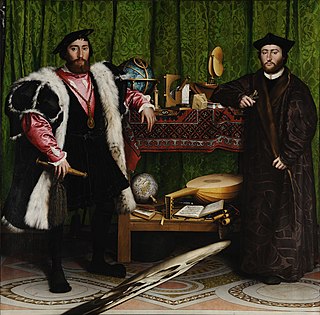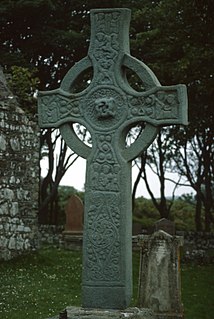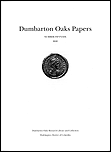
John the Evangelist is the name traditionally given to the author of the Gospel of John. Christians have traditionally identified him with John the Apostle, John of Patmos, or John the Presbyter, although this has been disputed by most modern scholars.

Nataraja is a depiction of the Hindu god Shiva as the divine cosmic dancer. His dance is called Tandavam or Nadanta, depending on the context of the dance. The pose and artwork is described in many Hindu texts such as the Anshumadbhed agama and Uttarakamika agama, the dance murti featured in all major Hindu temples of Shaivism, and is a well known sculptural symbol in India and popularly used as a symbol of Indian culture, in particular as one of the finest illustrations of Hindu art.

Garuda, also Galon or Nan Belu in Burmese and Karura in Japanese, is a legendary bird or bird-like creature in Hindu, Buddhist and Jain faith. He is variously the vehicle mount (vahana) of the Hindu god Vishnu, a dharma-protector and Astasena or the Eight Legions in Buddhism, and the Yaksha of the Jain Tirthankara Shantinatha. The Brahminy kite is considered as the contemporary representation of Garuda. He is younger brother of Aruna, the charioteer of Sun.

A Madonna is a representation of Mary, either alone or with her child Jesus. These images are central icons for both the Catholic and Orthodox churches. The word is from Italian ma donna 'my lady', albeit archaic. The Madonna and Child type is very prevalent in Christian iconography, divided into many traditional subtypes especially in Eastern Orthodox iconography, often known after the location of a notable icon of the type, such as the Theotokos of Vladimir, Agiosoritissa, Blachernitissa, etc., or descriptive of the depicted posture, as in Hodegetria, Eleusa, etc.

Iconography, as a branch of art history, studies the identification, description and interpretation of the content of images: the subjects depicted, the particular compositions and details used to do so, and other elements that are distinct from artistic style. The word iconography comes from the Greek εἰκών ("image") and γράφειν.

A misericord is a small wooden structure formed on the underside of a folding seat in a church which, when the seat is folded up, is intended to act as a shelf to support a person in a partially standing position during long periods of prayer.

The Military Saints, Warrior Saints and Soldier Saints are patron saints, martyrs and other saints associated with the military. They were originally composed of the Early Christians who were soldiers in the Roman army during the persecution of Christians, especially the Diocletianic Persecution of AD 303–313.
Cornish bagpipes are the forms of bagpipes once common in Cornwall in the 19th century. Bagpipes and pipes are mentioned in Cornish documentary sources from c.1150 to 1830 and bagpipes are present in Cornish iconography from the 15th and 16th centuries.

Sudarshana Chakra is a spinning, discus weapon, having 108 serrated edges used by the Hindu god Vishnu or Krishna. The Sudarshana Chakra is generally portrayed on the right rear hand of the four hands of Vishnu, who also holds a shankha, a Gada (mace) and a padma (lotus).

Mahapurana (महापुराण) or Trishashthilkshana Mahapurana is a major Jain text composed largely by Acharya Jinasena during the rule of Rashtrakuta ruler Amoghavarsha and completed by his pupil Gunabhadra in the 9th century CE. Mahapurana consists of two parts. The first part is Ādi purāṇa written by Acharya Jinasena. The second part is Uttarapurana which is the section composed by Gunabhadra.

The Kildalton Cross is a monolithic high cross in Celtic cross form in the churchyard of the former parish church of Kildalton (from Scottish Gaelic Cill Daltain, "Church of the Foster Son" on the island of Islay in the Inner Hebrides, Scotland. It was carved probably in the second half of the 8th century AD, and is closely related to crosses of similar date on Iona. It is often considered the finest surviving Celtic cross in Scotland, and is certainly one of the most perfect monuments of its date to survive in western Europe. The cross and the adjacent roofless medieval parish church are in the care of Historic Environment Scotland and are jointly a scheduled ancient monument. A simpler cross of late medieval date stands nearby.

Dumbarton Oaks Papers (DOP) is an academic journal founded in 1941 under the auspices of the Dumbarton Oaks Research Library and Collection for the publication of articles relating to Byzantine society and culture from the 4th to 15th century in the Roman Empire as well as its neighboring and successor states. The journal treats sources in medieval Greek, as well as other premodern languages, such as Arabic, Armenian, Coptic, Ethiopic, Georgian, Latin, Old Church Slavonic, and Syriac. Submissions address a range of topics, including art and iconography, architecture, archaeology, codicology, epigraphy, history, historiography, language, law, literature, music, numismatics, palaeography, science, sigillography, and theology.
Ann Buckley is an Irish musicologist, born in Dublin.

A hulk was a type of medieval sea craft, a technological predecessor of the carrack and caravel. The hulk appears to have remained a relatively minor type of sailing ship apparently peculiar to the Low Countries of Europe where it was probably used primarily as a river or canal boat, with limited potential for coastal cruising. The only evidence of hulks is from legal documents and iconography.

A tomb effigy, usually a recumbent effigy or, in French, gisant, is a sculpted figure on a tomb monument depicting in effigy the deceased. These compositions were developed in Western Europe in the Middle Ages, and continued in use through the Renaissance and early modern period; they are still sometimes used. They typically represent the deceased in a state of "eternal repose", lying with hands folded in prayer and awaiting resurrection. A husband and wife may be depicted lying side by side. An important official or leader may be shown holding his attributes of office or dressed in the formal attire of his official status or social class.
The Codrus Painter was a Greek vase-painter of the Attic red-figure style, who flourished between 440 and 420 BC. His actual name is unknown and his conventional name is derived from his name-vase, now in Bologna, which depicts the mythical Athenian king, Codrus. He is most famous for his red-figure kylix showing the deeds of Theseus, now in the British Museum. Stylistically the Codrus Painter is close to the Aison and the Eretria Painter, and his vases have been found in three tombs with these artists.
Sara Lipton is a medieval historian; she is a professor of history at Stony Brook University.

Lena Liepe, born 1962, is a Swedish art historian, who since 2017 is professor in art history at Linnaeus University, Sweden. She has worked at the University of Lund, Sweden, University of Tromsø, Norway and University of Oslo, Norway. Her main research areas are medieval art history, art theory and method, genus perspective on medieval art, and icelandic medieval illuminated manuscripts. In her research she has focused on how museums in Sweden grew out of 19th century displays of medieval church art, and for the moment she completes a major work on the importance of relics in medieval church art. Her broad approach to the studies of medieval art and illuminations have had a deep impact in the Nordic research in the different areas she has covered, and she has also been recognized internationally.
James France was a British-Danish businessman and historian of art and monasticism.
Margaret "Meg" Ann Twycross is a literary scholar and historian specialising in medieval theatre and iconography. She is Emeritus Professor at Lancaster University.













